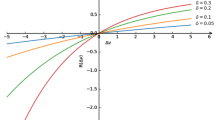Abstract
Unconventional emergencies usually have the characteristics of complexity, dynamic, and unpredictability, which greatly enhances the difficulty of emergency decision-making. Aiming at the multi-stage large group emergency decision-making problem featuring unknown stage weight and preference information expressed as interval numbers, we propose a new decision-making method. First, we present a similarity measurement formula for interval numbers. Each stage’s preference information is clustered using this similarity. To minimize the conflict of preferences, we derived two relative entropy optimization models to calculate the aggregation and stage weights. Next, we rank the alternatives based on the comprehensive group preference information. Finally, we present an illustrative example to verify the validity and practicability of this approach, and discuss several advantages of this method for managing emergency decision-making problems.
Similar content being viewed by others
References
Alonso S, Pérez IJ, Cabrerizo FJ (2013) A linguistic consensus model for web 2.0 communities. Appl Soft Comput 13(1):149–157
Baležentis T, Zeng SZ (2013) Group multi-criteria decision making based upon interval-valued fuzzy numbers: an extension of the MULTIMOORA method. Expert Syst Appl 40(2):543–550
Chai JY, Liu JNK, Xu ZS (2013) A rule-based group decision model for warehouse evaluation under interval-valued Intuitionistic fuzzy environments. Expert Syst Appl 40(6):1959–1970
Chen XH, Liu YF (2010) Expert weights determination method and realization algorithm based on interval numbers group decision matrices. Syst Eng Electron 32(10):2128–2131
Facchinetti G, Ricci RG, Muzzioli S (1998) Note on raking fuzzy triangular numbers. Int J Intell Syst 13(7):613–622
Fishburn PC, Gehrlein WV (1976) Borda’s rule, positional voting and condorcet’s simple majority principle. Public Choice 28(1):79–88
Goh CH, Tung YC, Cheng CH (1996) A revised weighted sum decision model for robot selection. Comput Ind Eng 30(2):193–199
Kuo MS, Liang GS (2012) A soft computing method of performance evaluation with MCDM based on interval-valued fuzzy numbers. Appl Soft Comput 12(1):476–485
Liu XY, Ju YB, Wang AH (2012) A multiple attribute group decision making method with its application to emergency alternative assessment. J Converg Inf Technol 7(2):75–82
Liu Y, Fan ZP, Zhang Y (2014) Risk decision analysis in emergency response: a method based on cumulative prospect theory. Comput Oper Res 42:75–82
Mao JJ, Yao DB, Wang CC (2013) A novel cross-entropy and entropy measures of IFSs and their applications. Knowl Based Syst 48:37–45
Meysam Mousavi S, Behnam V, Tavakkoli-Moghaddam R et al (2013) A multi-stage decision-making process for multiple attributes analysis under an interval-valued fuzzy environment. Int J Adv Manuf Technol 64(9):1263–1273
Mousavi SM, Makui A, Raissi S (2012) A multi-criteria decision-making approach with interval numbers for evaluating project risk responses. Int J Eng 25(5):121–129
Peng DH, Wang H (2014) Dynamic hesitant fuzzy aggregation operators in multi-period decision making. Kybernetes 43(5):715–736
Perez IJ, Cabrerizo FJ, Herrera-Viedma E (2010) A mobile decision support system for dynamic group decision-making problems. IEEE Trans Syst Man Cybern Part A Syst Hum 40(6):1244–1256
Shim KC, Fontane DG, Labadie JW (2002) Spatial decision support system for integrated river basin flood control. J Water Resour Plan Manag 128(3):190–201
Song GX, Yang H (2000) Research on group behavioral decision making. Acad Explor 57(3):48–49
Su ZX, Chen MY, Xia PP et al (2011) An interactive method for dynamic intuitionistic fuzzy multi-attribute group decision making. Expert Syst Appl 38(12):15286–15295
Wei GW, Zhao XF, Lin R (2012) Generalized triangular fuzzy correlated averaging operator and their application to multiple attribute decision making. Appl Math Model 36(7):2975–2982
Xia MM, Xu ZS (2012) Entropy/cross entropy-based group decision making under intuitionistic fuzzy environment. Inf Fusion 13(1):31–47
Xu ZS (2001) Algorithm for priority of fuzzy complementary judgement matrix. J Syst Eng 16(4):311–314
Xu ZS (2007) Multiple attribute group decision making with different formats of preference information on attributes. IEEE Trans Syst Man Cybern Part B 37(6):1500–1511
Xu ZS, Cai XQ (2013) On consensus of group decision making with interval utility values and interval preference orderings. Group Decis Negot 22(6):997–1019
Xu XH, Chen XH (2011) A conflict measure model and corresponding conflict coordination mechanism in large group decisions. J Syst Sci Inf 9(1):1–18
Xu JP, Wu ZB, Zhang Y (2014) A consensus based method for multi-criteria group decision making under uncertain linguistic setting. Group Decis Negot 23(1):127–148
Ye J (2011) Cosine similarity measures for intuitionistic fuzzy set and their applications. Math Comput Model 53(1):91–97
Zhang LY, Xu XH, Chen XH (2012) A new similarity measure for intuitionistic fuzzy sets and its applications. Int J Inf Manag Sci 23(2):229–239
Zhao M, Qiu WH, Liu BS (2010) Relative entropy evaluation method for multiple attribute decision making. Control Decis 25(7):1099–1104
Zhou SH, Yang J, Ding Y et al (2015) A Markov chain approximation to multi-stage interactive group decision-making method based on interval fuzzy number. Soft Comput. doi:10.1007/s00500-015-1973-1
Acknowledgments
The authors would like to thank the editors and anonymous reviewers for their insightful comments and suggestions. This paper was supported by grants from the Natural Science Foundation of China (71171202, 71210003, 71431006), the Mobile E-business Collaborative Innovation Center of Hunan Province, and the Key Laboratory of Hunan Province for Mobile Business Intelligence.
Author information
Authors and Affiliations
Corresponding author
Ethics declarations
Conflict of interest
We declare that we have no financial and personal relationships with other people or organizations that can inappropriately influence our work, there is no professional or other personal interest of any nature or kind in any product, service and/or company that could be constructed as influencing the position presented in, or the review of the manuscript entitled “A Multi-stage Conflict Style Large Group Emergency Decision-making Method”.
Additional information
Communicated by V. Loia.
Rights and permissions
About this article
Cite this article
Cai, Cg., Xu, Xh., Wang, P. et al. A multi-stage conflict style large group emergency decision-making method. Soft Comput 21, 5765–5778 (2017). https://doi.org/10.1007/s00500-016-2155-5
Published:
Issue Date:
DOI: https://doi.org/10.1007/s00500-016-2155-5




